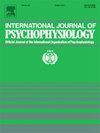The effect of high- and low-approach motivated sadness on frontal alpha asymmetry and other metrics
IF 2.6
3区 心理学
Q3 NEUROSCIENCES
引用次数: 0
Abstract
Sadness is commonly perceived as an affective state with negative valence. However, studies on the psychological and physiological effects of sadness have yielded mixed results. We proposed a systematic analysis of sadness, taking into account an additional dimension - the intensity of approach motivation, understood as an urge to move toward. We induced low and high approach motivation sadness while measuring electrical brain activity (EEG). We predicted that low approach motivation sadness and high approach sadness would evoke different patterns of frontal alpha activity. In our study, 41 participants were randomly assigned to a low or high approach motivation sadness induction. A significant interaction was observed when comparing low and high approach motivation sadness across the presented stories, as measured by the frontal alpha asymmetry index. To furtherly explore this effect, we conducted cluster-based permutation analysis on individual alpha peak-centered spectra, which revealed a more centrally diffused effect over the frontal areas in both hemispheres as well a significant activation over the occipital region. Low approach motivation sadness was associated with reduced alpha power over frontal areas, while high approach motivation sadness was associated with increased alpha power in the same region, both in comparison to neutral condition. These results might reflect Default Mode Network activation or the projection from occipital area. Based on these results, we propose a new perspective on sadness as a heterogeneous state that should be evaluated based on the intensity of approach motivation, rather than solely on its valence.
高接近动机和低接近动机的悲伤情绪对额叶阿尔法不对称性和其他指标的影响。
悲伤通常被认为是一种具有负面情绪的情感状态。然而,有关悲伤的心理和生理影响的研究结果不一。我们建议对悲伤情绪进行系统分析,同时考虑到一个额外的维度--接近动机的强度,接近动机被理解为一种走向他人的冲动。我们在测量脑电活动(EEG)的同时,诱发了低接近动机和高接近动机的悲伤情绪。我们预测,低接近动机悲伤和高接近动机悲伤会引起不同的额叶α活动模式。在我们的研究中,41 名参与者被随机分配到低接近动机悲伤和高接近动机悲伤的诱导中。通过额叶α不对称指数的测量,在比较低接近动机悲伤和高接近动机悲伤所呈现的故事时,我们观察到了明显的交互作用。为了进一步探究这一效应,我们对单个阿尔法峰中心频谱进行了基于聚类的置换分析,结果显示,在两个半球的额叶区域有更集中的扩散效应,而在枕叶区域也有显著的激活效应。与中性状态相比,低接近动机悲伤与额叶区域的阿尔法功率降低有关,而高接近动机悲伤与同一区域的阿尔法功率增加有关。这些结果可能反映了默认模式网络的激活或枕叶区的投射。基于这些结果,我们提出了一种新的观点,即悲伤是一种异质性状态,应根据接近动机的强度而非仅仅根据其价态来评估。
本文章由计算机程序翻译,如有差异,请以英文原文为准。
求助全文
约1分钟内获得全文
求助全文
来源期刊
CiteScore
5.40
自引率
10.00%
发文量
177
审稿时长
3-8 weeks
期刊介绍:
The International Journal of Psychophysiology is the official journal of the International Organization of Psychophysiology, and provides a respected forum for the publication of high quality original contributions on all aspects of psychophysiology. The journal is interdisciplinary and aims to integrate the neurosciences and behavioral sciences. Empirical, theoretical, and review articles are encouraged in the following areas:
• Cerebral psychophysiology: including functional brain mapping and neuroimaging with Event-Related Potentials (ERPs), Positron Emission Tomography (PET), Functional Magnetic Resonance Imaging (fMRI) and Electroencephalographic studies.
• Autonomic functions: including bilateral electrodermal activity, pupillometry and blood volume changes.
• Cardiovascular Psychophysiology:including studies of blood pressure, cardiac functioning and respiration.
• Somatic psychophysiology: including muscle activity, eye movements and eye blinks.

 求助内容:
求助内容: 应助结果提醒方式:
应助结果提醒方式:


